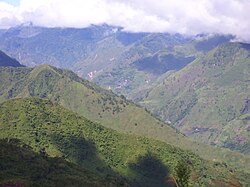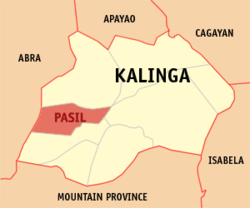Pasil | |
|---|---|
| Municipality of Pasil | |
 Pasil River Valley | |
 Map of Kalinga with Pasil highlighted | |
Location within the
Philippines | |
| Coordinates: 17°23′22″N 121°09′35″E / 17.3894°N 121.1597°E | |
| Country | Philippines |
| Region | Cordillera Administrative Region |
| Province | Kalinga |
| District | Lone district |
| Barangays | 14 (see Barangays) |
| Government | |
| • Type | Sangguniang Bayan |
| • Mayor | Alfredo B. Malannag Jr. |
| • Vice Mayor | Venancio O. Magangat |
| • Representative | Allen Jesse C. Mangaoang |
| • Municipal Council | Members |
| • Electorate | 7,212 voters ( 2022) |
| Area | |
| • Total | 189.00 km2 (72.97 sq mi) |
| Elevation | 971 m (3,186 ft) |
| Highest elevation | 2,000 m (7,000 ft) |
| Lowest elevation | 357 m (1,171 ft) |
| Population (2020 census)
[3] | |
| • Total | 10,577 |
| • Density | 56/km2 (140/sq mi) |
| • Households | 2,066 |
| Economy | |
| • Income class | 5th municipal income class |
| • Poverty incidence | 18.15 |
| • Revenue | ₱ 100.5 million (2020) |
| • Assets | ₱ 112.9 million (2020) |
| • Expenditure | ₱ 78.11 million (2020) |
| • Liabilities | ₱ 32.68 million (2020) |
| Service provider | |
| • Electricity | Kalinga - Apayao Electric Cooperative (KAELCO) |
| Time zone | UTC+8 ( PST) |
| ZIP code | 3803 |
| PSGC | |
| IDD : area code | +63 (0)74 |
| Native languages | Kalinga Ilocano Tagalog |
| Website |
www |
Pasil, officially the Municipality of Pasil, is a 5th class municipality in the southwestern part of the Kalinga. It is bounded on the north by the municipality of Balbalan, on the south by the municipality of Tinglayan, on the east by Tabuk city, and on the west by the province of Abra and south-western part of the municipality of Sadanga, Mountain Province. According to the 2020 census, it has a population of 10,577 people. [3]
Geography
Barangays
Pasil is politically subdivided into 14 barangays. [5] Each barangay consists of puroks and some have sitios.
- Ableg
- Bagtayan
- Balatoc
- Balenciagao Sur
- Balinciagao Norte
- Cagaluan
- Colayo
- Dalupa
- Dangtalan
- Galdang (Casaloan)
- Guina-ang ( Poblacion)
- Magsilay
- Malucsad
- Pugong
Climate
| Climate data for Pasil, Kalinga | |||||||||||||
|---|---|---|---|---|---|---|---|---|---|---|---|---|---|
| Month | Jan | Feb | Mar | Apr | May | Jun | Jul | Aug | Sep | Oct | Nov | Dec | Year |
| Mean daily maximum °C (°F) | 21 (70) |
23 (73) |
24 (75) |
26 (79) |
26 (79) |
25 (77) |
24 (75) |
24 (75) |
24 (75) |
24 (75) |
23 (73) |
21 (70) |
24 (75) |
| Mean daily minimum °C (°F) | 14 (57) |
15 (59) |
16 (61) |
17 (63) |
19 (66) |
19 (66) |
19 (66) |
19 (66) |
19 (66) |
17 (63) |
16 (61) |
15 (59) |
17 (63) |
| Average precipitation mm (inches) | 23 (0.9) |
28 (1.1) |
33 (1.3) |
64 (2.5) |
232 (9.1) |
242 (9.5) |
258 (10.2) |
266 (10.5) |
245 (9.6) |
201 (7.9) |
87 (3.4) |
69 (2.7) |
1,748 (68.7) |
| Average rainy days | 8.3 | 8.0 | 10.8 | 15.2 | 23.7 | 26.1 | 27.0 | 25.8 | 23.5 | 17.3 | 13.7 | 12.1 | 211.5 |
| Source: Meteoblue [6] | |||||||||||||
Demographics
| Year | Pop. | ±% p.a. |
|---|---|---|
| 1970 | 5,557 | — |
| 1975 | 6,755 | +3.99% |
| 1980 | 6,872 | +0.34% |
| 1990 | 7,572 | +0.97% |
| 1995 | 8,935 | +3.15% |
| 2000 | 9,360 | +1.00% |
| 2007 | 10,084 | +1.03% |
| 2010 | 9,626 | −1.68% |
| 2015 | 9,644 | +0.04% |
| 2020 | 10,577 | +1.83% |
| Source: Philippine Statistics Authority [7] [8] [9] [10] | ||
In the 2020 census, the population of Pasil, Kalinga, was 10,577 people, [3] with a density of 56 inhabitants per square kilometre or 150 inhabitants per square mile.
Economy
Graphs are unavailable due to technical issues. There is more info on
Phabricator and on
MediaWiki.org. |
Government
Local government
Pasil, belonging to the lone congressional district of the province of Kalinga, is governed by a mayor designated as its local chief executive and by a municipal council as its legislative body in accordance with the Local Government Code. The mayor, vice mayor, and the councilors are elected directly by the people through an election which is being held every three years.
Elected officials
| Position | Name |
|---|---|
| Congressman | Allen Jesse C. Mangaoang |
| Mayor | Alfredo B. Malannag Jr. |
| Vice-Mayor | Theodoro A. Mosing |
| Councilors | Marlo P. Bagni |
| Robert Bilarmino D. Ganito | |
| Speedy D. Lapaddic | |
| Shirley T. Taclawan | |
| Washington B. Bakidan | |
| Cecilia C. Bawagan | |
| Leonardo A. Banatao | |
| Ronnie B. Bawalan |
Folklore
In an earlier time, Kabunian–the supreme deity of the Kalinga–left a drop of water upon an ancient tree he passed on one of his travels. This drop trickled down and with a great force akin to magnetism, attracted nearby brooks and rivulets to form what is now called the Pasil River. [19]
References
- ^ Municipality of Pasil | (DILG)
- ^ "2015 Census of Population, Report No. 3 – Population, Land Area, and Population Density" (PDF). Philippine Statistics Authority. Quezon City, Philippines. August 2016. ISSN 0117-1453. Archived (PDF) from the original on May 25, 2021. Retrieved July 16, 2021.
- ^ a b c Census of Population (2020). "Cordillera Administrative Region (CAR)". Total Population by Province, City, Municipality and Barangay. Philippine Statistics Authority. Retrieved 8 July 2021.
- ^ "PSA Releases the 2018 Municipal and City Level Poverty Estimates". Philippine Statistics Authority. 15 December 2021. Retrieved 22 January 2022.
- ^ "Pasil municipality". Philippine Standard Geographic Code Interactive. Retrieved on 2011-12-20.
- ^ "Pasil: Average Temperatures and Rainfall". Meteoblue. Retrieved 8 March 2020.
- ^ Census of Population (2015). "Cordillera Administrative Region (CAR)". Total Population by Province, City, Municipality and Barangay. Philippine Statistics Authority. Retrieved 20 June 2016.
- ^ Census of Population and Housing (2010). "Cordillera Administrative Region (CAR)" (PDF). Total Population by Province, City, Municipality and Barangay. National Statistics Office. Retrieved 29 June 2016.
-
^ Censuses of Population (1903–2007).
"Cordillera Administrative Region (CAR)".
Table 1. Population Enumerated in Various Censuses by Province/Highly Urbanized City: 1903 to 2007.
National Statistics Office.
{{ cite encyclopedia}}: CS1 maint: numeric names: authors list ( link) - ^ "Province of Kalinga". Municipality Population Data. Local Water Utilities Administration Research Division. Retrieved 17 December 2016.
- ^ "Poverty incidence (PI):". Philippine Statistics Authority. Retrieved December 28, 2020.
- ^ "Estimation of Local Poverty in the Philippines" (PDF). Philippine Statistics Authority. 29 November 2005.
- ^ "2003 City and Municipal Level Poverty Estimates" (PDF). Philippine Statistics Authority. 23 March 2009.
- ^ "City and Municipal Level Poverty Estimates; 2006 and 2009" (PDF). Philippine Statistics Authority. 3 August 2012.
- ^ "2012 Municipal and City Level Poverty Estimates" (PDF). Philippine Statistics Authority. 31 May 2016.
- ^ "Municipal and City Level Small Area Poverty Estimates; 2009, 2012 and 2015". Philippine Statistics Authority. 10 July 2019.
- ^ "PSA Releases the 2018 Municipal and City Level Poverty Estimates". Philippine Statistics Authority. 15 December 2021. Retrieved 22 January 2022.
- ^ "2019 National and Local Elections" (PDF). Commission on Elections. Retrieved March 13, 2022.
- ^ "Pasil Municipal Profile". NERBAC Cordillera Administrative Region. Retrieved on 2011-12-20.
External links
- Philippine Standard Geographic Code
- Pasil LGU Profile on the Local Governance Performance Management System
- Philippine Census Information

